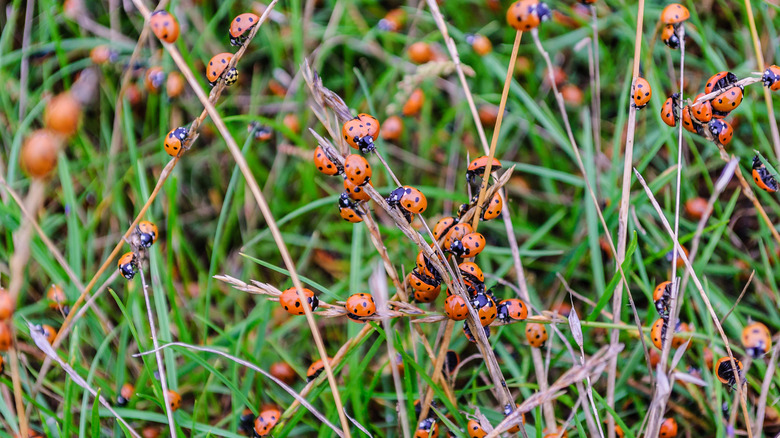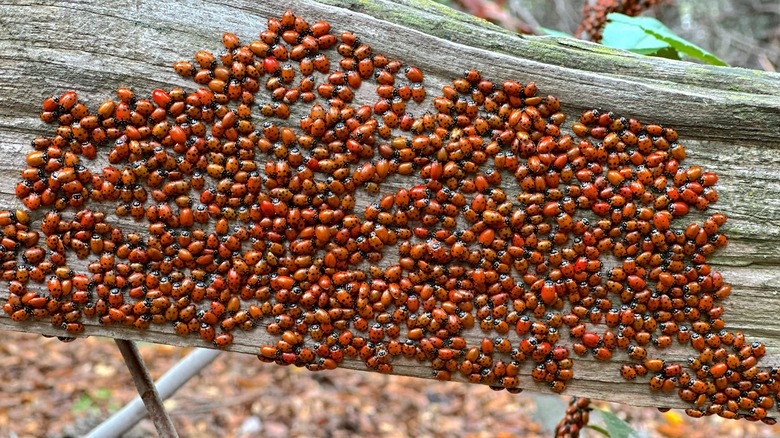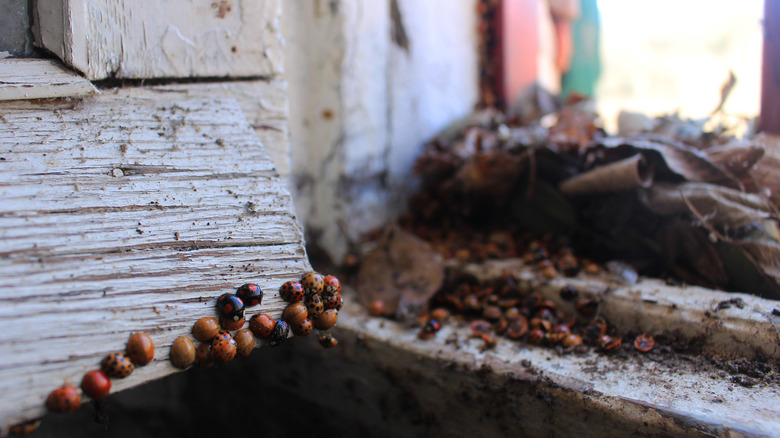Reasons Why Your Yard Is Swarmed With Ladybugs
As the main subject of many children's stories and general symbols of good luck, ladybugs have long been considered one of those friendly insects that you shouldn't kill in the garden. However, one big misconception about them is that they are all the same when, in fact, ladybugs are actually not a single type of insect but rather a group of beetles containing over 500 species (in North America alone) that range in color from the classic red to orange, brown, or yellow. Because there are so many types of ladybugs, there are many reasons why they may be drawn to your yard; however, as major predators of the insect world, the biggest reason these spotted insects are often drawn to specific places is because they are full of prey.
What constitutes ladybug prey? As it turns out, they eat a lot of garden pests including not just aphids but also other annoying garden destroyers like mites and scale. On top of this, they also like consuming pollen and are more likely to visit your yard if it is full of ladybug-friendly plants like sunflowers, cilantro, chives, caraway, calendula, dill, fennel, marigolds, zinnias, and dahlias. However, if you do have a swarm of ladybugs in your yard, you may want to be careful because large groups of them are not always a good thing.
The bad reason why ladybugs may be swarming in your yard
Unfortunately, despite what all the children's books would have you believe, ladybugs are not always the hero of the story. In fact, one specific type of ladybug — the Asian lady beetle — is not only invasive but also may be swarming in your yard in autumn because it plans to move into your house for the winter. This happens because, in their native climates of Russia, China, Japan, and Korea; Asian lady beetles evolved to spend winters in the cracks and crevices of rock piles and cliff sides. Unfortunately, outside of their native environments, these beetles often mistake the cracks and crevices in homes (specifically light-colored ones) for a nice warm rockpile to hibernate in.
When these beetles find a good overwintering location, they often release smelly pheromones that attract more ladybugs. This can lead to a ladybug infestation which is not only annoying but can also cause allergic reactions in humans and can be toxic to pets if eaten in large quantities. When threatened, Asian lady beetles also release a yellow chemical that can stain walls and other surfaces inside your home.
How to keep an Asian lady beetle swarm out of your house
Unfortunately, because Asian lady beetles are so invasive, they are now the most common type of ladybug in North America. This means that chances are that the autumn ladybug swarm in your backyard will have plans to overwinter somewhere nice and cozy. So, how can you convince these ladybugs that your home is not the right spot?
Because ladybugs are attracted to bright colors and lights, one small way you can try and keep them from settling in your house is to change your outdoor lights to yellow bulbs (yellow porch lights can also keep other types of insects away) and switch off interior lights when you are not using them. You can also help make it harder for the ladybugs to enter your home by sealing up any cracks and by adding door sweeps to the bottom of your doors. You should also trim any trees or bushes that touch your home and inspect any plants for ladybugs before you bring them inside for the winter. If ladybugs do end up in your home, you can easily vacuum or sweep them up and then deposit them back outside. Many insect specialists recommend refraining from killing ladybugs unless necessary because they are beneficial for gardens and yards.


